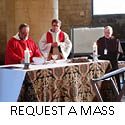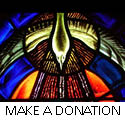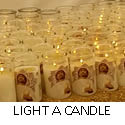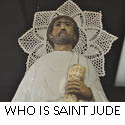Pilgrims to the National Shrine of Saint Jude first pass through the parish church of Our Lady of Mount Carmel, which is itself a place of prayer and beauty.
The present church building was opened in 1937. The building that is now the Church of Our Lady of Mount Carmel has had a chequered history. It was built by William Hall in 1861 as a Quaker school, which explains its church-like appearance. Faversham was the centre of a gunpowder making industry that was largely controlled by Quakers. The directors and foreman of the company were Quakers and they built a school to give their children a religious education in accordance with their beliefs. The original layout included a courtyard under the building, now enclosed to form the parish hall (Carmel Hall). On the outside of the pillars supporting the building (now the wall of the Hall) on the North, or car park side, can be seen the grooves and marks where the children used to sharpen their slate pencils.
What happened to the Quaker school?
The school continued in being until 1907 when the girls moved to amalgamate with a boys' school and so form a new school in new premises (The Ethelbert Road Council School). During the First World War, on 2nd April 1916, there was an enormous explosion in the local powder works down on the marshes. The gravestone of some 150 victims of the tragedy can still be seen in the local cemetery, where they were only afforded a communal grave. When the war was over, powder making moved north into Scotland. In 1910 the building was acquired by East Kent Cinemas, and after some alterations opened its doors as the Empire Picture Hall. The screen occupied the place of the main windows in the Church, and the projection shed was in the garden behind the present Calvary. Eventually a new cinema was built in the centre of the town and the building became vacant in 1936. In 1926 the Carmelites were given charge of the parish of Faversham, with the Church in Plantation Road (built in 1906 to accommodate 65 people!). In 1937 the disused Empire Picture Hall was purchased together with the house and the land and, after conversion, dedicated as the Church of Our Lady of Mount Carmel superceeding the Church in Plantation Road.

on Tanners Street in Faversham.

Brother Anthony McGreal, O.Carm., (d. 1965) who for over 30 years
helped to develop the Carmelite presence at Faversham.
The old church, until its demolition in 1963, served as a chapel for the Convent (Plantation House) from which the Notre Dame Sisters conducted a primary school. The cost of the house and the redundant cinema was a mere £900, and so the new Church and Priory of Faversham came into being. That is not to say that the Catholics of the town liked it. They thought that Tanners Street was a bit down market as an area, but as time went on they began to see more sense in the proposition.

Friars greeting parishioners after Mass.

The interior of the parish church of Our Lady of Mount Carmel, Faversham.
High altar
The high altar was made to the design of an old carver from the Rochester School of Art. He also carved the rood behind the high altar. The central figure of Christ is perfectly done, but the figures of Saint John and Our Lady are unfinished because the carver's right arm became stiff through arthritis. The group were erected in their unfinished state. The peculiar thing about that decision is that many artists and art historians admire the unfinished statues more than they admire other statuary in the church.

The Rood (Cross) behind the High Altar.
Floor and panelling
The floor of the church is of Australian Jarrah wood, and the oak panelling around the walls came from the old Church House, Dean's Yard, Westminster Abbey. These old headquarters of Anglican administration were pulled down to make room for the new Church House. Fr. Elias Lynch, O.Carm., bought much of the oak panelling from the old place at scrap prices and used it to add a little glory to the old cinema. What he did not need is now scattered over many places in North East Kent.

A Carmelite preaching in the parish church.
Murals by Edward Ardizzone
The murals in the Sanctuary are by Edward Ardizzone. Many people knew of him as a first rate line artist and illustrator of books. If you see a copy of "My Uncle Silas" by H. E. Bates, you will see Mr Ardizzone's inimitable line drawings illustrating its pages. If you want a quiet chuckle and at the same time to delight your eye, you cannot do better than find a copy of it. The work in the church at Faversham was Mr Ardizzone's first attempt at mural painting, and the result is a joy to see.

The altar and rood, flanked by Ardizzone's murals.
Flanking the rood (cross) are two angels.


The angels painted by Edward Ardizzone.
The angels look down upon two scenes in the life of the Blessed Virgin Mary, Our Lady. On the left is "The Presentation of Our Lady in the Temple" and on the right is "The Visitation of Our Lady to Elizabeth".

"The Presentation" mural by Edward Ardizzone.

"The Visitation" mural by Edward Ardizzone.
The font
The Baptismal Font is by Anthony Foster and was originally in the outer area of St. Jude's Shrine. On each side of the octagonal font are carvings of early Christian symbols - an eagle, a ship with the sail bearing the crosses keys of St. Peter, a winged bull, a winged lion, a fish, an angel, a flame and a cross.

The font in Our Lady of Mount Carmel parish church.
Shrine of the Holy Infant Jesus of Prague
On the left as you face the altar is a side chapel that houses a small shrine of the Holy Infant Jesus of Prague. The original statue of the Infant Jesus is in the Discalced Carmelite Church in Prague, and came originally from Spain. It was brought to Bohemia by a Spanish princess whose family had treasured it as a miraculous heirloom. The princess's daughter was generous to the Carmelites, and presented it to the friars saying, "I hereby give you what I prize most highly in this world. So long as you venerate this image you shall not want." From that time onwards the community prospered both spiritually and temporally. But when the devotion to the Infant Jesus was relaxed, God's blessing seemed to depart from the house.
The statue in the chapel came from Prague, and is the work of the Czech sculptor Krechler, and is as near a copy as we could get of the world famous statue there. You may notice in it the high cheek bones of the Slav race. The crown is of course, the crown of Bohemia because he is the Little King - the King of Bohemia. The original vestments, which are a copy of the court robes of Bohemia in the 16th century, were made by the nuns of a convent near the Church of the Divine Infant of Prague. The vestments, in use at present, on the statue were made by a benefactor, and are changed according to the liturgical seasons. In June 1938 the Archbishop of Southwark gave permission for the erection in Faversham of the Confraternity of the Holy Infant of Prague, and affiliated it to the Arch-confraternity of the Merciful Child Jesus of Prague in the Church of Our Lady of Victories in Prague. The Confraternity, now known as the Society of the Infant Jesus, exists to promote the love and veneration of the Holy Name of Jesus, and by God's grace to establish his reign in the hearts of all through faith, hope and love.

The Krechler statue of the Infant of Prague.
It is not known where the stained glass window above the statue came from. It depicts, on the left, Blessed Juliana of Mount Cornillon and, on the right, Saint Clare. Blessed Juliana was a nun of Cornillon, near Liege, Belgium, and to her more than anybody else the institution of the feast of Corpus Christi is due. Her suggestion initially met with opposition, but the feast was formally adopted in the diocese of Liege in 1246. Saint Clare joined Saint Francis, and founded the first convent of Franciscan nuns, now called "Poor Clares". She died in 1253.
Shrine of the Little Flower
On a wall in the little side chapel is the small Shrine of the Little Flower. Saint Thérèse of Lisieux, known as 'the Little Flower', was born in 1873 and died in 1897. She became a Carmelite nun when she was fifteen, and inspired many through her "Little Way" of simplicity and in the doing of small acts inspired by love.
The shrine at Faversham is rather unusual, because instead of presenting St. Thérèse, standing in isolated intercession and favour, she is linked up with Our Blessed Lady of Mount Carmel and the Holy Child. The roses which she distributes come to her from the Holy Child by favour of Our Blessed Lady. In other words, the Shrine links up St. Thérèse of Lisieux with Our Blessed Lady of Mount Carmel and the Holy Child. The shrine is particularly associated with the Society of the Little Flower.

The Faversham Shrine of St. Thérèse, the "The Little Flower".
Other artwork in the Church
Several statues in the church are the focus of devotion to Our Lady of Mount Carmel, Saint Joseph, and Saint Thérèse of Lisieux.



The statues of Our Lady of Mount Carmel, St. Joseph, and St. Thérèse.
Parish Hall (Carmel Hall)
Underneath the forecourt leading to the house is a vaulted space that used to be a sort of armoury for the local musketry school. It was later devoted to the more peaceful pursuit of making habits for the friars, and Brown Scapulars for members of the Brown Scapular Confraternity. In 2005 it was renovated to serve as the parish hall and is used for a wide variety of activities and local groups.












